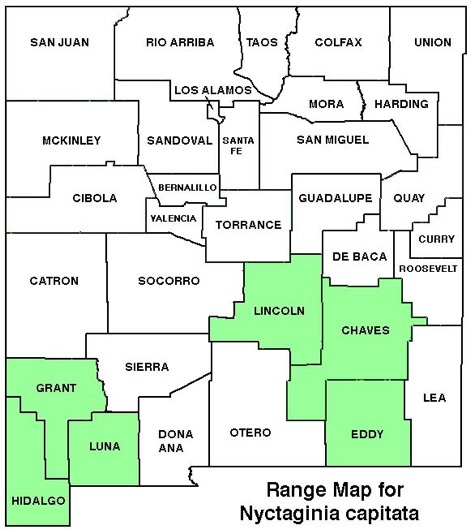WILDFLOWERS OF NEW MEXICO

The stem and leaves are sticky and the flowers musty smelling, but you’ll want to stoop down and look anyway. Upright to sprawling stems 4–16-inches long fork repeatedly and are covered with sticky hairs. Note the showy cluster of red, tubular flowers with stamens extending beyond the throat. Flowers open in the evening and close in the heat of the next day.
FLOWER: April–November, especially after rains. Dense, rounded clusters with 5–18 musty smelling, red to pink flowers grow on 1–5 3/4-inch long (2–14 cm) stems (peduncles). Fused sepals form the 1–1 1/8-inch long (25–30 mm), funnel-shaped flowers that open with 5 spreading, petal-like lobes; stamens extend beyond the throat. Leaf-like bracts grow at the base of each cluster.
LEAVES: Opposite. Leaves hairy, on 3/8–1 1/8-inch (1–8 cm) long stems (petioles); blades, triangular with tapering tips, 1 1/2–3 1/2-inches long (4–9 cm), 1/4–2 3/16-inch wide (6–55 mm); margins entire to wavy.
HABITAT: Sandy, gravelly soils, roadsides, disturbed areas; desert grasslands and scrub.
ELEVATION: 3,300–4,500 feet.
RANGE: NM, TX.
SIMILAR SPECIES: Other long, tubular four-o’clocks have white flowers. Purple (Narrow-Leaf) Sand-Verbena, Abronia angustifolia, in much the same habitat and range, has clusters of pinkish-purple flowers with the stamens inside the throat.
NM COUNTIES: Southern NM in low-elevation, arid habitats: Chaves, Eddy, Grant, Hidalgo, Lincoln, Luna.

SCARLET MUSKFLOWER, DEVIL'S BOUQUET
NYCTAGINIA CAPITATA
Four-O’Clock Family, Nyctaginaceae
Perennial herb

THE CONTENTS OF THIS WEBSITE ARE COPYRIGHTED AND CANNOT BE USED
WITHOUT PERMISSION OF GEORGE OXFORD MILLER


EMAIL ME